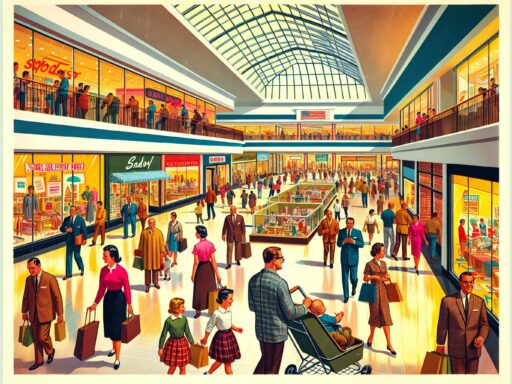Retail estate encompasses commercial properties designed for selling goods and services, including stores, shopping centers, and retail parks. These strategically located spaces maximize foot traffic and sales potential, making them crucial for retail business success.
As online shopping grows and consumer habits shift, retail estate’s role continues evolving. Physical spaces now complement digital experiences rather than compete with them. This transformation impacts urban planning, community development, and how modern cities take shape.
Understanding Retail Estate
Retail estate refers to commercial properties used for selling products and services. This includes boutique stores, shopping malls, and retail parks positioned in high-traffic, visible locations to attract customers and boost sales.
The changing retail landscape has transformed these spaces from simple shopping destinations into experiential hubs. Modern retail estate integrates digital components with traditional brick-and-mortar elements to meet evolving consumer expectations.
These properties significantly influence urban development by affecting zoning laws and community infrastructure. Developers analyze retail trends and demographic data to create environments that serve both retailers and consumers while generating local employment and economic growth.
Key Components of Retail Estate
Retail estate involves several integral elements that define its functionality and viability in the market. These components include retail properties and the dynamics of tenancy and leasing.
Retail Properties
Retail properties come in various formats to serve different commercial needs:
- Shopping centers: Multi-retailer complexes offering diverse shopping options
- Strip malls: Convenience-focused stores with shared parking
- Stand-alone buildings: Individual properties for unique brand experiences
Each format attracts specific demographics and requires strategic placement to optimize traffic flow and visibility.
Tenancy and Leasing
Property owners and retail tenants form relationships through lease agreements that vary in terms and flexibility. Longer leases often secure lower rates, while flexible options accommodate changing business models. Key factors affecting lease attractiveness include rent terms, tenant mix, and adaptability to market conditions.
Types of Retail Estate
Retail estate encompasses various property types that cater to diverse business needs and consumer behaviors. Understanding these categories helps stakeholders make informed decisions in the real estate market.
Shopping Malls
Large complexes featuring multiple stores, restaurants, and entertainment venues. Located in high-traffic areas, malls use anchor stores to draw crowds while supporting smaller specialty shops. They provide ample parking and convenient access to enhance the shopping experience.
Strip Malls
Row-style developments with shared front parking, typically housing essential services like grocery stores, salons, and restaurants. Positioned along major roads for maximum visibility and accessibility, strip malls offer lower operating costs for small businesses and local entrepreneurs.
Stand-Alone Stores
Single-tenant buildings allowing retailers to create unique brand presence and customer experiences. Examples include big-box stores, restaurants, and specialty shops. These properties require prime locations with significant foot and vehicle traffic for optimal performance.
Factors Influencing Retail Estate Value
Several key elements impact retail estate value, driving investment choices and strategic planning. Location, market trends, and consumer behavior are crucial components that contribute to a property’s valuation.
Location
High-traffic areas near transportation hubs and developed regions command higher values. Proximity to complementary businesses like restaurants and entertainment venues increases appeal. Accessibility and visibility directly impact consumer engagement and sales performance.
Market Trends
Consumer preferences drive retail estate values through changing demands. The shift toward online shopping requires tech-integrated physical spaces. Economic indicators like employment rates and disposable income also affect market conditions and property values.
Consumer Behavior
Changing preferences for convenience, unique experiences, and brand engagement influence location choices. Demographic shifts including urbanization and aging populations dictate store formats and retail offerings, affecting property attractiveness and investment potential.
The Role of Technology in Retail Estate
Technology enhances retail estate through improved customer experiences and operational efficiency. Digital kiosks and interactive displays engage customers while providing product information and promotions.
Data analytics help retailers understand consumer behavior, optimize product mixes, and target promotions effectively. This enables efficient inventory management that aligns offerings with demand patterns, reduces waste, and maximizes profitability.
Augmented reality (AR) and virtual reality (VR) create immersive experiences, allowing customers to visualize products in different settings. These technologies enhance decision-making and customer satisfaction.
Technology also supports seamless omnichannel retail experiences, integrating physical and online shopping. Many retailers employ apps and platforms to facilitate in-store pickups and enhance convenience. These solutions cater to consumer preferences, blending traditional retail with digital resources.
CRM data integration further enhances these digital ecosystems by consolidating customer information across touchpoints, enabling retailers to deliver personalized recommendations, track purchase histories, and build lasting customer relationships that drive repeat business.
Automated systems streamline operations through efficient inventory management and transaction processing. Self-checkout kiosks and mobile payments expedite purchases while improving customer satisfaction.
Retailers also benefit from implementing an employee attendance system that tracks staff schedules, manages shift changes, and ensures adequate floor coverage during peak shopping hours, optimizing labor costs while maintaining quality customer service.
Truly, the list goes on and on.
Challenges Facing Retail Estate
E-commerce Competition
Online shopping dominance shifts consumer preferences from traditional stores, requiring innovative approaches to attract foot traffic and enhance in-store experiences.
High Operating Costs
Rent, utilities, and labor expenses strain profit margins. Prime urban locations with high visibility often carry elevated price tags, making competition difficult for smaller retailers.
Evolving Consumer Expectations
Demand for personalized, convenient shopping experiences requires significant technology investments in digital infrastructure, data analytics, and mobile applications.
Economic Fluctuations
Market downturns reduce consumer spending, affecting tenant sales and leasing activity. This can lead to vacancies and reduced property values, impacting investor returns.
Sustainability Demands
Increasing pressure for eco-friendly building practices and energy-efficient operations requires investment in sustainable technologies and compliance with environmental regulations.
Discover the Power of BlueNotary:
Integrate your Business, Title Company, or Law Firm to Satisfy your Customers and Decrease TurnaroundGet a document Notarized/Sign-up
Join the Free Notary Training Facebook Group
Conclusion
Retail estate remains a dynamic and essential component of the commercial property market, influencing urban development and economic growth. As consumer preferences and technology evolve, stakeholders must adapt to these changes by integrating digital and physical experiences. Strategic Location, flexible leasing, and understanding demographic shifts are key to optimizing retail spaces. Embracing technology and sustainability will help retailers and investors meet modern consumer expectations and maintain competitive portfolios. By navigating these challenges and opportunities, the retail estate can continue to thrive in the ever-changing market landscape.
Frequently Asked Questions
What is a retail estate in the commercial property market?
Retail estate refers to properties specifically designed for retail activities, including boutique stores, shopping malls, and retail parks. These spaces are strategically located to enhance visibility and attract customer foot traffic, which is crucial for sales success.
How does retail estate impact urban development?
Retail estate plays a pivotal role in urban development by influencing zoning laws, shaping city landscapes, and affecting community infrastructure. It also stimulates local economies by generating employment and promoting business growth within urban economic frameworks.
Why is location important for the retail estate?
Location is crucial because properties situated in high-traffic areas with proximity to complementary businesses tend to attract more consumers. This enhanced visibility and foot traffic can increase sales potential and make a property more appealing to tenants and investors.
How are changing consumer habits affecting retail estate?
As consumer habits shift towards online shopping, there is a need for retailers to integrate physical spaces with digital experiences. This adaptation transforms retail spaces into experiential hubs, offering unique shopping experiences that appeal to modern consumer expectations.
What are the different types of retail properties?
Retail properties are categorized into shopping malls, strip malls, and stand-alone stores. Shopping malls are large complexes with diverse retail, dining, and entertainment options. Strip malls feature rows of stores with shared parking, while stand-alone stores allow for a distinct brand presence.
What is the role of tenancy and leasing in the retail estate?
Tenancy and leasing involve the relationship between property owners and retail tenants. Retail estate trends are influencing lease structures, with a move towards flexible leasing options to accommodate changing business models, tenant mixes, and current market trends.
How does technology influence retail estate?
Technology transforms retail estate by enhancing shopping experiences and optimizing operations. Retailers use digital kiosks, interactive displays, and data analytics to engage customers, while technologies like AR and VR provide immersive experiences that boost customer satisfaction.
What challenges does retail estate face today?
Retail estate faces challenges such as the rise of e-commerce, high operating costs, and evolving consumer expectations. Economic fluctuations can impact retail stability, leading to vacancies, while sustainability demands require eco-friendly technology investments for continued relevance.








